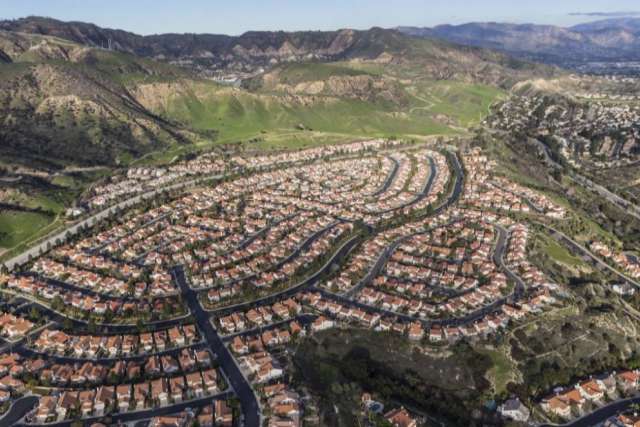Photo: An aerial view of Aliso Canyon. (Photo courtesy of Los Angeles County Department of Public Health)
UCLA scientists are embarking on a comprehensive, five-year study to understand the health consequences of what is, to this day, the nation’s largest natural gas blowout. From 2015-16, an estimated 109,000 metric tons of methane was released into the air from the Southern California Gas Company’s Aliso Canyon underground gas storage facility in the San Fernando Valley.
On Nov. 1, the Los Angeles County Department of Public Health awarded roughly $21 million to UCLA to conduct a wide-ranging assessment of the disaster.
The Aliso Canyon Disaster Health Research Study will collect rich health information through multiple sources, including birth records, a cancer registry, blood specimens, and resident surveys, said Honghu Liu, PhD, co-principal investigator and professor and chair of the Section of Public and Population Health in the School of Dentistry, and professor in the UCLA Fielding School of Public Health and David Geffen School of Medicine at UCLA.
“We’re looking at the full picture,” Dr. Liu said. “We want to find out what actually is the impact of the exposure on people’s health and find out the true health status of the affected community, after the exposure, over time and currently.”
The nearly 30-investigator, multi-disciplinary and -institute team also will analyze environmental emissions data collected during the blowout, along with contemporaneous data to address questions about the extent of exposure then and now.
Dr. Liu’s co-principal investigator is Michael Jerrett, PhD, director of the UCLA Center for Occupational and Environmental Health.
Health impacts
The blowout, which occurred over 111 days starting with initial detection on Oct. 23, 2015, led to immediate complaints from residents of foul odors, oily mists and health symptoms including headaches, nausea, coughing, and eye, nose and throat irritation.
At the time, roughly 232,200 residents lived within a 5-mile radius of the facility located near Porter Ranch. Dr. Liu said the disaster resulted in the displacement of nearly 10,000 families and led to temporary school closures.
According to L.A. County Public Health, many residents reported ongoing health problems and expressed concern about potential long-term effects.
In 2018, state and local officials secured a $119.5 million settlement from Southern California Gas that included $25 million for a long-term health study.
Health and well-being will be examined from multiple angles, said the study’s project manager, Nadereh Pourat, PhD, director of the Health Economics and Evaluation Research Program at the UCLA Center for Health Policy Research.
Researchers will study available data on health care use such as emergency room visits by ZIP code after the blowout, birth outcomes such as prematurity or birth defects, and rates of cancer.
“We are trying to look for evidence of short-term impact and longer-term consequences of exposure,” said Dr. Pourat, a professor of health policy and management at the UCLA Fielding School of Public Health. “For example, we’re going to look at health care claims and utilization to see what evidence we can find.”
Measuring longer-term impacts, such as the development of cancer or other conditions, will pose a challenge during the five-year study duration, she noted. The grant has the option for extension of up to five additional one-year periods.
“There are some consequences that may take longer to appear before they can be observed,” said Dr. Pourat. “Cancer may or may not develop in the timeframe we’re looking at.”
UCLA intends to recruit a significant number of residents who live in the affected area, to undergo blood work and health assessments such as pulmonary and cardiovascular function, said Dr. Liu.
He said participants will be recruited from the affected communities, such as Porter Ranch, Chatsworth, Northridge and Granada Hills. Additionally, UCLA will identify a control group of residents from a non-affected area with similar demographics for comparison.
Multitude of effects
The research team also will study residents’ mental health, quality of life, stress levels and even economic consequences from the blowout. For instance, some residents may have experienced disruption from temporary shelter, missed work due to symptoms or worried about the exposure to their families and pets.
“This impact is significant,” Dr. Liu said. “It penetrated basically every corner.”
"We want to find out what actually is the impact of the exposure on people's health and find out the true health status of the affected community, after the exposure, over time and currently."
dr. honghu liu
Another UCLA study leader, Diane Garcia-Gonzales, PhD, worked on the ground during the leak to sample air quality while she was a doctoral student at UC Berkeley. An air quality and climate change scientist, Dr. Garcia-Gonzales said residents were concerned not only about their emissions exposure during the blowout, but routine exposure from living nearby.
“A really important part of the study is looking at this issue more holistically: not just looking at the composition of the gas or looking solely at the health impacts,” Dr. Garcia-Gonzales said. “There’s also the mental health of those who have been affected.
“This was quite a traumatic event for them to go through. Many of them didn’t realize this facility existed before the blowout. It’s a source of continuous stress for them.”
The broad economic consequences from the disaster that residents may have experienced include an inability to work because of illness, or costs of medical treatment, Dr. Pourat said.
“There are downstream consequences to poor health,” she said. “That’s why really understanding what happened to people in the long-term matters – not just in the immediate impact it had on the health of the individual.”
Whether by participating in surveys, volunteering as study participants or serving on a community advisory board, participation from community members will be essential to the study.
To acquire more data, researchers also plan to seek out people who have since moved out of the area.
“The community that has been affected by this disaster has been actively seeking answers to what happened,” Dr. Pourat said. “We need to understand what are the issues of importance to the community when we are developing our survey questions.”
Environmental exposure
Along with health data, the UCLA team will conduct a complex environmental analysis and modeling of the exposure residents faced at the time of the leak and after.
“The exposure happened back in 2015, but there were preliminary studies and continuing monitoring since the disaster,” Dr. Liu said. Previous data sets include samples from air, soil and water.
The team hopes to narrow down what the community was exposed to during the blowout, Dr. Garcia-Gonzales said: “We know there are some potentially carcinogenic chemicals along the pipelines of oil and natural gas.”
Dr. Garcia-Gonzales recalled conducting indoor sampling inside houses in the area after the remediation period.
“It’s possible that the emissions that occurred at the site did penetrate into people’s homes and they were exposed in indoor environments as well,” she said.
The groups most vulnerable to emissions exposure include older adults, children, pregnant women and people with preexisting conditions, she said.
Dr. Liu said researchers also will work to determine the relationship between residents’ proximity to the leaking storage well and the degree of impact on their health.
A detailed report will be produced for the public, which Dr. Liu said could be helpful to scientists, government officials and communities in the event of future environmental disasters.
“What we learn from this study will provide practical information about what the degree of exposure actually is, the impact on people’s health and emotional state, and even the economic consequences,” Dr. Liu said. “Also logistically, how we actually deal with this kind of disaster from a personal and community point of view.”
Learn more about the Aliso Canyon Gas Leak Health Study.
Courtney Perkes is the author of this article.



